The Bernstein Operational Matrices for Solving the Fractional Quadratic Riccati Differential Equations with the Riemann-Liouville Derivative
Abstract
We obtain the approximate analytical solution for the fractional quadratic Riccati differential equation with the Riemann-Liouville derivative by using the Bernstein polynomials (BPs) operational matrices. In this method, we use the operational matrix for fractional integration in the Riemann-Liouville sense. Then by using this matrix and operational matrix of product, we reduce the problem to a system of algebraic equations that can be solved easily. The efficiency and accuracy of the proposed method are illustrated by several examples.
1. Introduction
The Riccati differential equation is named after the Italian Nobleman Count Jacopo Francesco Riccati (1676–1754). The book of Reid [1] contains the fundamental theories of the Riccati equation, with applications to random processes, optimal control, and diffusion problems. Moreover, it is well known that the one-dimensional static Schrödinger equation is closely related to a Riccati differential equation [2]. Solitary wave solution of a nonlinear partial differential equation can be represented as a polynomial in two elementary functions satisfying a projective Riccati equation [3].
The general response expression (1) contains a parameter α, the order of the fractional derivative that can be varied to obtain various responses. In the case that α is integer, then (1) is reduced to the classical Riccati differential equation.
This problem to develop the analytical and numerical method to solve the Riccati differential equation with standard derivative, the Caputo fractional derivative and the Riemann-Liouville fractional derivative, has attracted much attention and has been studied by many authors [5–18].
The aim of this work is using the Bernstein polynomials for solving the problem (1) and (2). We notice that the problem presented [18] was in the Caputo sense but in our work, the problem is with the Riemann-Liouville derivative; therefore we considered a more general space of functions. Also, in [18], the authors used the polynomials in the form of = (i = 0, 1, …, m) that is different from the standard Bernstein polynomials. So, the operational matrices in this work are different from those in [18].
The organization of this paper is as follows. In Section 2, the Bernstein polynomials are introduced. Some basic definitions and properties of the fractional calculus and also the BPs operational matrix for the Riemann-Liouville fractional integration are presented in Section 3. In Section 4, by BPs operational matrices, we solve the fractional quadratic Riccati differential equation. In Section 5, we discuss the convergence of the proposed method. In Section 6, several examples are considered to evaluate the power and effectiveness of the presented method. Some conclusions are summarized in the last section.
2. The Bernstein Polynomials and Their Properties
3. BPs Operational Matrix for the Riemann-Liouville Fractional Integration
In this section, firstly, we give some basic definitions and properties of the fractional calculus which are used further in this paper.
Definition 1 (see [4], [22]–[24].)Let α ≥ 0; the operator , defined on L1[a, b] by
Definition 2 (see [4], [22]–[24].)Let α ≥ 0 and n = ⌈α⌉; the operator , defined by
Definition 3 (see [4], [22]–[24].)Let α ≥ 0, n = ⌈α⌉, and dnf(x)/dxn∈L1[a, b]. The operator , defined by
Lemma 4. If α ≥ 0, n = ⌈α⌉, and a ≤ t ≤ b, then
Theorem 5. One can get BPs operational matrix Fα from order (m + 1)×(m + 1) for the Riemann-Liouville fractional integral as
Proof. See [21].
4. BPs for Solving the Fractional Quadratic Riccati Differential Equation
Firstly, we use the initial conditions to reduce a given initial-value problem to a problem with zero initial conditions.
5. Convergence Analysis
In this section, we investigate the convergence analysis for the method presented in Section 4.
Theorem 6. Suppose that u*(t) ∈ C1[0, 1] is the exact solution of (31) and , where
Theorem 7. Suppose that u*(t) ∈ C1[0, 1] is the exact solution of (31) and um(t) ∈ Sm is the obtained solution of (26). Then one has um(t) → u*(t) as m → ∞.
Proof. Substituting (17), (19), (20), and (12) in (32) we have
On the other hand, from Theorem 6 we obtained as m → ∞. Therefore we can write um → u* as m → ∞ and the proof is complete.
6. Illustrative Numerical Examples
In this section, we apply our method with m = 10 (BPs of degree m = 10) to solve the following examples. We define ym(t) and y(t) for the approximate solution and the exact solution, respectively.
Example 1. Consider the nonlinear Riccati differential equation [14]:
| t | Exact | Present method m = 10 |
Reference [14] |
|---|---|---|---|
| 0.1 | 0.099668 | 0.099668 | 0.099668 |
| 0.2 | 0.197375 | 0.197375 | 0.197375 |
| 0.3 | 0.291313 | 0.291313 | 0.291313 |
| 0.4 | 0.379949 | 0.379949 | 0.379944 |
| 0.5 | 0.462117 | 0.462117 | 0.462078 |
| 0.6 | 0.537050 | 0.537050 | 0.536857 |
| 0.7 | 0.604368 | 0.604368 | 0.603631 |
| 0.8 | 0.664037 | 0.664037 | 0.661706 |
| 0.9 | 0.716298 | 0.716298 | 0.709919 |
| 1 | 0.761594 | 0.761594 | 0.746032 |
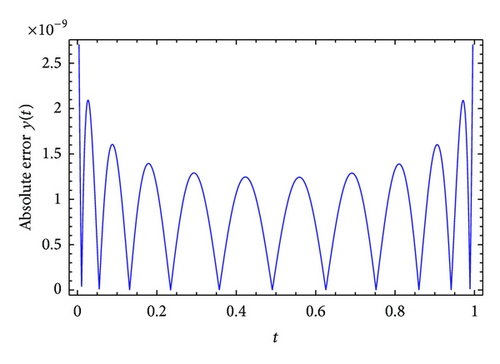
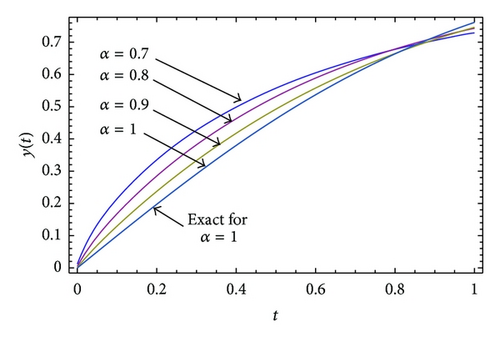
Example 2. Consider the following quadratic Riccati differential equation of fractional order [14]
| t | Exact | Present method m = 10 |
Reference [14] |
|---|---|---|---|
| 0.1 | 0.110295 | 0.110295 | 0.110294 |
| 0.2 | 0.241977 | 0.241977 | 0.241965 |
| 0.3 | 0.395105 | 0.395105 | 0.395106 |
| 0.4 | 0.567812 | 0.567812 | 0.568115 |
| 0.5 | 0.756014 | 0.756014 | 0.757564 |
| 0.6 | 0.953566 | 0.953566 | 0.958259 |
| 0.7 | 1.152949 | 1.152949 | 1.163459 |
| 0.8 | 1.346364 | 1.346364 | 1.365240 |
| 0.9 | 1.526911 | 1.526911 | 1.554960 |
| 1 | 1.689499 | 1.689499 | 1.723810 |
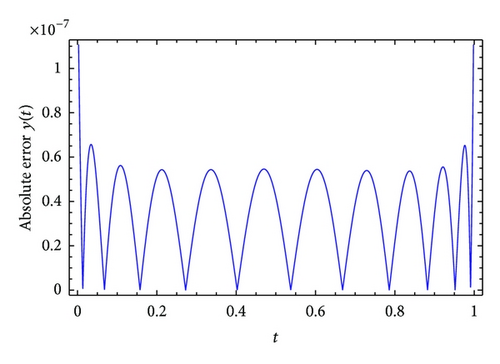
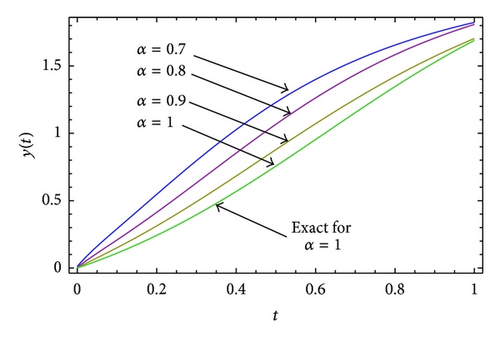
Example 3. Consider the nonlinear fractional differential equation:
| t | Present method m = 10 |
ADM [25] | FDTM [26] | BPFs [27] |
|---|---|---|---|---|
| 0.1 | 0.023779 | 0.023790 | 0.023790 | 0.023800 |
| 0.2 | 0.067336 | 0.067330 | 0.067330 | 0.067335 |
| 0.3 | 0.123886 | 0.123896 | 0.123896 | 0.123900 |
| 0.4 | 0.191373 | 0.191362 | 0.191362 | 0.191368 |
| 0.5 | 0.268851 | 0.268856 | 0.268856 | 0.268862 |
| 0.6 | 0.356235 | 0.356238 | 0.356238 | 0.356244 |
| 0.7 | 0.453958 | 0.453950 | 0.453950 | 0.453956 |
| 0.8 | 0.562999 | 0.563007 | 0.563007 | 0.563014 |
| 0.9 | 0.685066 | 0.685056 | 0.685056 | 0.685067 |
| 1 | 0.822540 | 0.822511 | 0.822509 | 0.822525 |
| t | Present method m = 10 |
ADM [25] | FDTM [26] |
|---|---|---|---|
| 0.1 | 0.000952 | 0.000952 | 0.000952 |
| 0.2 | 0.005383 | 0.005383 | 0.005383 |
| 0.3 | 0.014833 | 0.014833 | 0.014833 |
| 0.4 | 0.030450 | 0.030450 | 0.030450 |
| 0.5 | 0.053197 | 0.053197 | 0.053197 |
| 0.6 | 0.083925 | 0.083925 | 0.083925 |
| 0.7 | 0.123412 | 0.123412 | 0.123412 |
| 0.8 | 0.172391 | 0.172391 | 0.172391 |
| 0.9 | 0.231574 | 0.231574 | 0.231574 |
| 1 | 0.301676 | 0.301676 | 0.301676 |
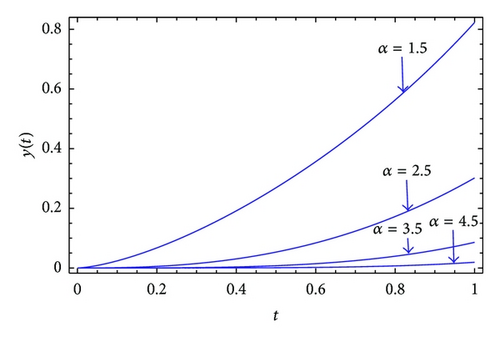
7. Conclusion
In this paper, we proposed a numerical method for solving the fractional quadratic Riccati differential equations by the operational matrices of the Bernstein polynomials. We applied operational matrix for fractional integration in the Riemann-Liouville sense. Then by using this matrix and operational matrix of product, we reduced the fractional quadratic Riccati differential equation to a system of algebraic equations that can be solved easily. Finally, examples have been simulated to demonstrate the high performance of the proposed method. We saw that the results were in good agreement with the analytical solutions and the solutions in the open literatures. Also, we observed that the solutions approach to classical solutions as the order of the fractional derivatives approaches 1, for fixed m.




